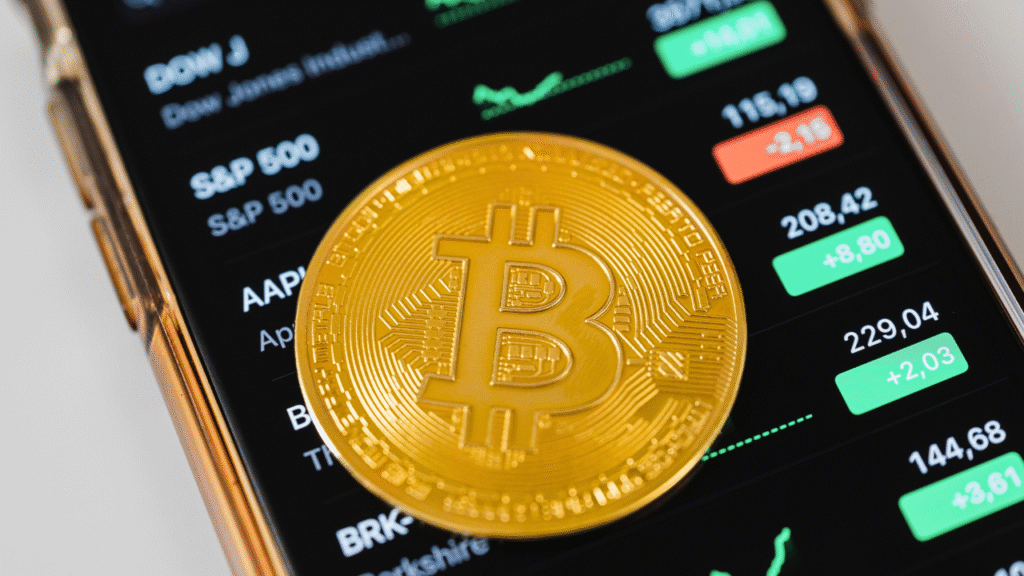What’s Cryptocurrency? best review in |2025|

Introduction
What’s cryptocurrency? This is a question that’s becoming increasingly common as digital currencies like Bitcoin and Ethereum make headlines. Whether you’ve heard about people becoming millionaires overnight or about the volatility of crypto markets, one thing is certain: cryptocurrency is here to stay. In this comprehensive guide, we’ll explain what cryptocurrency is, how it works, why it matters, and what you should consider before diving in.
What’s Cryptocurrency in Simple Terms?
Cryptocurrency is a digital or virtual currency that uses cryptography for security. Unlike traditional currencies such as the U.S. dollar or euro, cryptocurrencies aren’t issued by a central authority like a government or bank. Instead, they are decentralized and typically operate on a technology called blockchain—a transparent and tamper-resistant digital ledger.
Key characteristics:
- Digital-only: No physical coins or bills.
- Decentralized: Controlled by a network, not a single authority.
- Secure: Transactions are encrypted and validated.
- Borderless: Can be sent anywhere in the world almost instantly.
A Brief History of Cryptocurrency
- 1980s–1990s: Early Concepts
Before Bitcoin, there were attempts like DigiCash and e-gold, but they failed due to lack of adoption and centralization issues. - 2008: The Birth of Bitcoin
An anonymous figure named Satoshi Nakamoto published a whitepaper titled “Bitcoin: A Peer-to-Peer Electronic Cash System”. This introduced the world to blockchain and decentralized currency. - 2009–2012: Bitcoin Takes Off
The first Bitcoin transaction was made in 2009. In 2010, someone famously bought two pizzas for 10,000 BTC, marking the first real-world Bitcoin purchase. - 2015 Onward: Rise of Ethereum and Altcoins
Ethereum introduced smart contracts, enabling decentralized applications (dApps). Thousands of alternative cryptocurrencies (altcoins) followed, offering various features.
How Does Cryptocurrency Work?
1. Blockchain Technology
At its core, cryptocurrency runs on a blockchain, which is a chain of blocks containing transaction data. Every transaction is verified by a network of computers (called nodes) and added to the chain. This makes it nearly impossible to alter past transactions.
2. Mining and Validation
- Proof of Work (PoW): Used by Bitcoin. Miners solve complex math problems to validate transactions and earn new coins.
- Proof of Stake (PoS): Used by Ethereum (post-merge). Validators stake their coins to secure the network and earn rewards.
3. Wallets and Keys
To use cryptocurrency, you need a wallet. This can be software-based (apps, desktop programs) or hardware devices for higher security.
- Public key: Your crypto address (like an email address).
- Private key: Your password — never share it.
Popular Cryptocurrencies You Should Know

- Bitcoin (BTC) – The first and largest cryptocurrency by market cap.
- Ethereum (ETH) – Known for smart contracts and decentralized apps.
- Tether (USDT) – A stablecoin pegged to the U.S. dollar.
- Binance Coin (BNB) – Utility token for the Binance exchange ecosystem.
- Solana (SOL) – Fast, low-cost blockchain for DeFi and NFTs.
Why Do People Use Cryptocurrency?
- Investment and Speculation: Many buy crypto hoping its value will rise.
- Decentralization: No government or bank control.
- Fast, Low-Cost Transfers: Send funds worldwide in minutes.
- Financial Inclusion: Access for people without bank accounts.
- Smart Contracts & dApps: Automate agreements and build decentralized platforms.
Risks and Challenges
While cryptocurrency has opened the door to new financial opportunities, it also comes with significant risks that every user or investor should understand. Knowing these challenges will help you make informed decisions and avoid costly mistakes.
1. Extreme Volatility
One of the most well-known characteristics of cryptocurrency is its price volatility. Unlike traditional currencies or even stocks, the value of cryptocurrencies can rise or fall dramatically in a short period.
- Example: Bitcoin has experienced swings of over 20% in a single day, while smaller coins (altcoins) can see even sharper fluctuations.
- Why it happens: Crypto markets are still relatively young, with lower liquidity compared to traditional markets. They are also heavily influenced by speculation, news cycles, and market sentiment.
- Impact on users: While volatility can present opportunities for high returns, it also increases the likelihood of sudden, steep losses especially for new investors who buy at peak prices.
2. Security Threats and Cyber Risks
Cryptocurrency operates in a digital environment, which makes it a target for hackers and scammers.
- Hacks on Exchanges: Centralized crypto exchanges have been breached, resulting in billions of dollars in stolen funds.
- Phishing and Scams: Fraudsters often trick users into revealing private keys or sending funds to fake addresses.
- Loss of Private Keys: In cryptocurrency, control of your private key equals control of your funds. If you lose it or it gets stolen, there’s no way to recover your coins.
- Malware and Wallet Vulnerabilities: Weak security measures on personal devices or poorly coded wallets can leave users exposed.
3. Regulatory Uncertainty
Governments around the world are still debating how to regulate cryptocurrency. This creates a constantly shifting legal landscape.
- Different approaches: Some countries embrace crypto innovation, while others ban or heavily restrict it.
- Tax implications: Many jurisdictions treat cryptocurrency as property or an asset, meaning every trade or sale may trigger a taxable event.
- Impact on businesses: Exchanges and crypto companies face evolving compliance requirements, which can affect the availability of services in certain regions.
- Risk to investors: Sudden regulatory crackdowns or bans can cause market prices to plummet and limit access to crypto platforms.
4. Lack of Consumer Protections
Traditional banks and payment processors provide a level of safety and recourse for customers. Cryptocurrency, being decentralized, offers no such safety net.
- No Chargebacks: Once a crypto transaction is sent, it can’t be reversed. If you send funds to the wrong address or fall victim to a scam, there’s no way to recover them.
- No FDIC Insurance: In most cases, funds stored in crypto wallets or exchanges are not protected by government-backed insurance programs like the FDIC in the U.S.
- Exchange Collapses: When major crypto exchanges fail — such as the high-profile FTX collapse — customers often lose access to their funds entirely.
5. Technological and Operational Risks

Beyond financial risks, cryptocurrency users face operational challenges:
- Blockchain Bugs: Software vulnerabilities in blockchain protocols can be exploited by attackers.
- Network Congestion: High transaction volumes can slow down processing times and increase fees.
- User Error: Sending funds to the wrong wallet address or incorrectly setting transaction fees can result in permanent loss.
- Scalability Issues: Some blockchains struggle to handle large-scale adoption, leading to inconsistent performance.
How to Buy Cryptocurrency
- Choose a Reliable Exchange
Examples: Coinbase, Binance, Kraken. Look for security measures, low fees, and ease of use. - Create an Account and Verify Identity
Most exchanges require KYC (Know Your Customer) verification. - Deposit Funds
You can use a bank transfer, credit card, or other crypto. - Buy Cryptocurrency
Select the coin you want and place an order. - Store Securely
Move long-term holdings to a private wallet for extra security.
Cryptocurrency vs Traditional Money
| Feature | Cryptocurrency | Traditional Money |
|---|---|---|
| Control | Decentralized | Central banks/governments |
| Speed | Minutes (or seconds) | Hours to days |
| Fees | Often low | Can be high |
| Physical Form | None | Notes and coins |
| Supply | Often capped (e.g., Bitcoin) | Can be printed anytime |
The Future of Cryptocurrency
When asking “what’s cryptocurrency and where is it headed?”, it’s clear that this technology is more than just a passing trend. Experts believe that blockchain and digital assets will continue to evolve, reshaping global finance, commerce, and even the internet itself.
1. Central Bank Digital Currencies (CBDCs)
Many governments are exploring CBDCs, which are digital versions of national currencies issued by central banks.
Potential impact: They might coexist with decentralized cryptocurrencies or compete directly, depending on regulatory policies. technological innovation, and market adoption.
Examples: China’s digital yuan and pilot projects by the European Central Bank and U.S. Federal Reserve.
Why they matter: CBDCs could combine the speed of crypto with the stability of government backing.
2. Mainstream Adoption for Payments
Cryptocurrency could move from niche speculation to everyday use:
- Retail payments: Major brands already accept Bitcoin, and payment processors are adding crypto support.
- Cross-border transactions: Faster and cheaper than traditional wire transfers.
- Micropayments and streaming money: Crypto enables tiny, instant payments for content, services, or IoT devices.
- Challenges to overcome: Price volatility, user education, and smoother interfaces.
3. Growth of Decentralized Finance (DeFi)
DeFi platforms use smart contracts to replace banks and brokers with code, allowing users to borrow, lend, trade, and earn interest without intermediaries.
- Opportunities: Higher yields, greater financial inclusion, 24/7 access.
- Risks: Smart contract bugs, hacks, and lack of regulation still pose major threats.
- Future direction: Increased security audits, institutional adoption, and hybrid models blending DeFi with traditional finance.
4. Integration with AI and the Internet of Things (IoT)
The convergence of blockchain, artificial intelligence, and IoT could transform how machines and humans interact financially.
- Smart devices paying each other: Imagine your electric car automatically paying a charging station using cryptocurrency.
- AI-driven trading: Algorithms managing portfolios or automating payments in real time.
- Decentralized identity and data marketplaces: Users controlling and monetizing their own data securely on blockchain networks.
5. Regulation as the Deciding Factor
The path forward for cryptocurrency will be shaped heavily by government regulation:
- Clear frameworks could attract institutional investors and stabilize markets.
- Overly strict rules could stifle innovation or drive crypto activity underground.
- Balanced policies will likely focus on consumer protection, taxation, and anti-money laundering compliance while allowing room for innovation.
Conclusion
So, what’s cryptocurrency? It’s far more than just a digital trend or an investment buzzword it’s a revolutionary technology that is reshaping how we think about money, ownership, and global finance. By combining cryptography, decentralization, and blockchain innovation, cryptocurrency has introduced a financial system without borders, middlemen, or centralized control.
From Bitcoin’s emergence in 2009 to the explosion of thousands of altcoins, decentralized finance (DeFi), and NFTs, the cryptocurrency landscape has evolved at lightning speed. While it offers opportunities for investment, faster payments, and financial inclusion, it also carries significant risks volatility, cybersecurity threats, regulatory uncertainty, and the lack of consumer protections.
The future of cryptocurrency will likely involve greater regulation, mainstream adoption, and integration with emerging technologies like AI, IoT, and Central Bank Digital Currencies (CBDCs). Whether cryptocurrency becomes a universal medium of exchange or remains a specialized digital asset, it has already proven that the future of money will be digital, decentralized, and global.
The key takeaway: If you’re curious about cryptocurrency, take the time to learn before you leap. Educate yourself on wallets, private keys, and market risks, and never invest more than you can afford to lose. Understanding what’s cryptocurrency today will help you navigate the opportunities and challenges of tomorrow’s financial world with confidence. see
